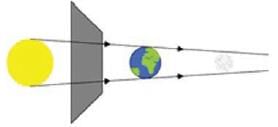Olympiad Test: Earth And Universe - 2 - Class 5 MCQ
15 Questions MCQ Test - Olympiad Test: Earth And Universe - 2
If the Earth is 93 million miles away from the sun.

Jupiter is 483.4 million miles away from the sun.
How many miles apart are Jupiter and the Earth from each other?

Jupiter is 483.4 million miles away from the sun.
How many miles apart are Jupiter and the Earth from each other?
Earth is closest to the Sun during which season in the northern hemisphere?
Where is the Earth’s circumference the greatest?
We see astronauts floating in space due to the:
When the Moon is partly hidden by the dark shadow of the Earth, it is called:
An artificial satellite revolves around the Earth in:
Which is the first Indian satellite to go into space?
Which of the following statements are correct?
i. Satellites are small heavenly bodies that revolve around the Sun.
ii. Milky Way is a spiral-shaped galaxy.
iii. Planet Venus has 63 moons.
iv. One revolution of the Earth is complete when it revolves around the Sun
The first American satellite was named as ____ and it was put into orbit on ____














